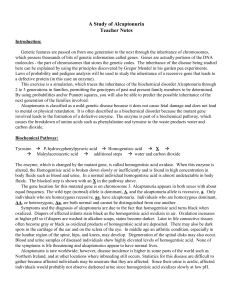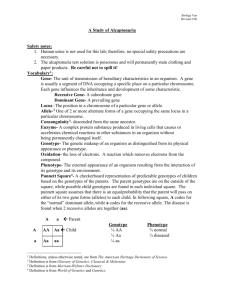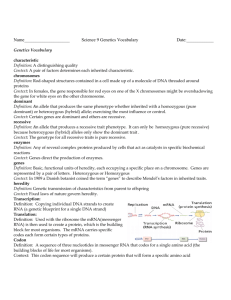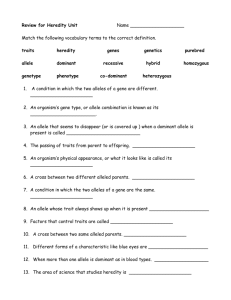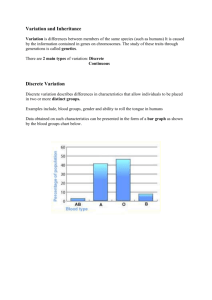A Study of Alcaptonuria
advertisement
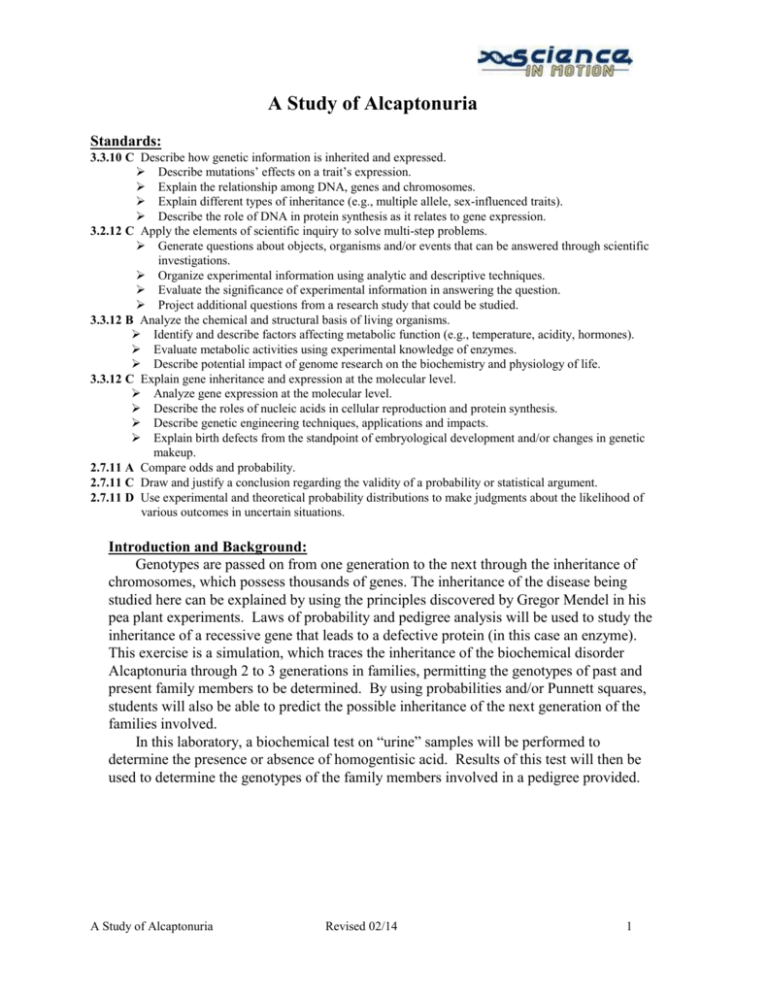
A Study of Alcaptonuria Standards: 3.3.10 C Describe how genetic information is inherited and expressed. Describe mutations’ effects on a trait’s expression. Explain the relationship among DNA, genes and chromosomes. Explain different types of inheritance (e.g., multiple allele, sex-influenced traits). Describe the role of DNA in protein synthesis as it relates to gene expression. 3.2.12 C Apply the elements of scientific inquiry to solve multi-step problems. Generate questions about objects, organisms and/or events that can be answered through scientific investigations. Organize experimental information using analytic and descriptive techniques. Evaluate the significance of experimental information in answering the question. Project additional questions from a research study that could be studied. 3.3.12 B Analyze the chemical and structural basis of living organisms. Identify and describe factors affecting metabolic function (e.g., temperature, acidity, hormones). Evaluate metabolic activities using experimental knowledge of enzymes. Describe potential impact of genome research on the biochemistry and physiology of life. 3.3.12 C Explain gene inheritance and expression at the molecular level. Analyze gene expression at the molecular level. Describe the roles of nucleic acids in cellular reproduction and protein synthesis. Describe genetic engineering techniques, applications and impacts. Explain birth defects from the standpoint of embryological development and/or changes in genetic makeup. 2.7.11 A Compare odds and probability. 2.7.11 C Draw and justify a conclusion regarding the validity of a probability or statistical argument. 2.7.11 D Use experimental and theoretical probability distributions to make judgments about the likelihood of various outcomes in uncertain situations. Introduction and Background: Genotypes are passed on from one generation to the next through the inheritance of chromosomes, which possess thousands of genes. The inheritance of the disease being studied here can be explained by using the principles discovered by Gregor Mendel in his pea plant experiments. Laws of probability and pedigree analysis will be used to study the inheritance of a recessive gene that leads to a defective protein (in this case an enzyme). This exercise is a simulation, which traces the inheritance of the biochemical disorder Alcaptonuria through 2 to 3 generations in families, permitting the genotypes of past and present family members to be determined. By using probabilities and/or Punnett squares, students will also be able to predict the possible inheritance of the next generation of the families involved. In this laboratory, a biochemical test on “urine” samples will be performed to determine the presence or absence of homogentisic acid. Results of this test will then be used to determine the genotypes of the family members involved in a pedigree provided. A Study of Alcaptonuria Revised 02/14 1 Science In Motion Juniata College Alcaptonuria Pathway: Biochemical Pathway One enzyme that is needed for the breakdown of tyrosine is homogentisic acid oxidase. When this enzyme is altered, the homogentisic acid is broken down slowly or inefficiently and is found in high concentration in body fluids such as blood and urine. In a normal individual homogentisic acid is almost undetectable in body fluids. The blocked step, caused by the deficient enzyme, is shown with an X in the pathway on the left. The gene location for this mutated gene is on chromosome 3 (3q21-q23). Alcaptonuria appears in both sexes with almost equal frequency. The wild type (normal) allele is dominant, A, and the alcaptonuria allele is recessive, a. Only individuals who are homozygous recessive, aa, have alcaptonuria. Individuals who are homozygous dominant, AA, or heterozygous, Aa, are both normal and cannot be distinguished from one another. If an individual is heterozygous, they are referred to as a “carrier” because of their potential to pass on the recessive gene to their children. Symptoms and the diagnosis of alcaptonuria are due to the fact that homogentisic acid turns black when oxidized. Diapers of affected infants stain black as the homogentisic acid oxidizes in air. Oxidation increases at higher pH so if diapers are washed in alkaline soaps, stains become darker. Later in life, ochronosis (o-kron- sis) may occur. Ochronosis is when connective tissues become gray or black as oxidized products of homogentisic acid are deposited. There may also be dark spots in the cartilage of the ear and on the sclera of the eye. In middle age an arthritic condition (called ochronotic arthropathy), especially in the hips and knees, as well as the lumbar region of the spine, may develop. Degeneration of the spinal disks may also occur. Blood and urine samples of diseased individuals show highly elevated levels of homogentisic acid. Alcaptonuria is rare worldwide; however, disease incidence is higher in some parts of the world such as Northern Ireland, and at other locations where consanguinity still occurs. Statistics for this disease are difficult to gather because affected individuals may be unaware that they are affected. Since their urine is acidic, affected individuals would probably not observe darkened urine since homogentisic acid oxidizes slowly at low pH. Pedigrees: Figure 2 (see page 5) Figure 2 shows the pedigrees of four families that can be analyzed. Individuals with alcaptonuria are darkened in after being confirmed by lab tests. In family I, the father must be Aa in order for his son, to have alcaptonuria (genotype aa). The daughter must also be Aa, 2 A Study of Alcaptonuria Revised 02/14 Science In Motion Juniata College inheriting the A allele from her father and the a allele from her mother. In family II, only the daughter has alcaptonuria, therefore, she must have inherited one allele from her father and her mother, both carriers. The genotype of the brother cannot be determined without DNA analysis. In family III, we can determine the genotype of all individuals except the two paternal grandparents. Knowing that the affected individuals are homozygous recessive and normal individuals are either heterozygous or homozygous dominant, we can do pedigree analysis and say with certainty that all normal individuals are heterozygous including one of the paternal grandparents. What we can’t prove without further testing is: Which paternal grandparent is heterozygous? What is the genotype of the other paternal grandparent? Is it AA or Aa? In family IV, the girl in the third generation is marked “?”. She has not had a urine test done so her phenotype is unknown. Pedigree analysis proves that her mother has the genotype Aa and the fact that her father is an alcaptonuric means he has the genotype aa. Genetic counselors use these facts (and a Punnett square) to say that she has a 50% chance of being alcaptonuric and 50% chance of being heterozygous. Guiding questions: 1. How is a recessive disease passed down through a family? 2. Can you name some recessive diseases? Vocabulary1: Gene- The unit of transmission of hereditary characteristics in an organism. A gene is usually a segment of DNA occupying a specific place on a particular chromosome. Each gene influences the inheritance and development of some characteristic. Recessive Gene- A subordinate gene Dominant Gene- A prevailing gene Locus- The position in a chromosome of a particular gene or allele. Allele2- One of 2 or more alternate forms of a gene occupying the same locus in a particular chromosome. Consanguinity3- descended from the same ancestor. Enzyme- A complex protein substance produced in living cells that causes or accelerates chemical reactions in other substances in an organism without being permanently changed itself. Genotype- The genetic makeup of an organism as distinguished from its physical appearance or phenotype. Oxidation- the loss of electrons. A reaction which removes electrons from the compound. Phenotype- The external appearance of an organism resulting from the interaction of its genotype and its environment. Punnett Square4- A checkerboard representation of predictable genotypes of children based on the genotypes of the parents. The parent genotypes are on the outside of the square, while possible child genotypes are found in each individual square. The punnett square assumes that there is an equal probability that the parent will pass on either of its two gene forms (alleles) to each child. In following square, A codes for the “normal” dominant allele, while a codes for the recessive allele. The disease is found when 2 recessive alleles are together (aa). 3 A Study of Alcaptonuria Revised 02/14 Science In Motion Juniata College Materials: urine samples in labeled cuvettes alcaptonuria test solution Safety: 1. Human urine is not used for this lab; therefore, no special safety precautions are necessary. 2. The alcaptonuria test solution is poisonous and will permanently stain clothing and paper products. Be careful not to spill it! Procedure: 1. Obtain a cuvette rack containing the urine samples of family members. 2. Mark the pedigree (Figure 3, page 7) with the following labels, which correspond to the labels on the urine samples. PGF - paternal grandfather PGM - paternal grandmother MGF - maternal grandfather MGM - maternal grandmother M - mother F - father MA - maternal aunt PA - paternal aunt MU - maternal uncle PU - paternal uncle B - brother S - sister 3. Test the urine of each person by adding 2-3 drops of the alcaptonuria test solution to each sample. 4. Look for positive tests (formation of dark precipitate). 5. Determine which family members have the disease and mark them on the pedigree (Figure 3) by coloring in their symbol and denoting the proper genotype. 6. Apply Punnett square principles to determine each person’s probable genotype. 7. Mark the genotype in the two lines below each person’s symbol on Figure 3. 8. Dispose of the urine properly (it may be flushed down the sink) and thoroughly rinse out all tubes with water only. Tube racks with tubes in them may then be placed upside down on a paper towel to dry. 4 A Study of Alcaptonuria Revised 02/14 Science In Motion Juniata College Figure 2 = male = marriage = generations = female = affected individual = carrier Family I Family II Aa aa aa Aa a Aa A? aa A a a A Aa Aa a aa aa Aa A AA a Aa Aa aa Family III A Aa Aa aa A? Aa A? a A AA Aa a Aa aa A a a Aa aa a Aa aa Aa aa Family IV aa aa Aa Aa Aa Aa ? = ½ Aa; ½ aa aa Aa ? 5 A Study of Alcaptonuria Revised 02/14 Science In Motion Juniata College Figure 3 Data: I. 1__ 2__ 3__ 4__ II. 1__ 2__ 3__ 4__ 1__ 2__ 5__ 6__ III. Data: Circle the people who had a positive test result. PGF PGM MGF MGM M F MA PA MU PU B S Questions: 1. Is alcaptonuria caused by a gene mutation or a chromosome mutation? Explain! 2. Is alcaptonuria a sex-linked trait? Why or why not? 6 A Study of Alcaptonuria Revised 02/14 Science In Motion Juniata College 3. Can you determine the homozygous from the heterozygous genotype by looking at the phenotype of the individual? If yes, how? If no, why not? 4. Why are recessive trait diseases not common in human populations? 5. Explain how a genetic counselor would use information from a pedigree obtained from a biochemical test to predict patterns of inheritance in members of the next generation. 6. Could a genetic disease “suddenly” show up in a family? If so, how would you explain the inheritance of the disease state to an affected child’s parents? 7. What is the probability of the sister having a child with alcaptonuria if she marries a heterozygous male? a homozygous dominant male? 8. How does the disease originate in an individual? 7 A Study of Alcaptonuria Revised 02/14 Science In Motion Juniata College References: Definitions, unless otherwise noted, are from The American Heritage Dictionary of Science. 2 Definition is from Glossary of Genetics- Classical & Molecular. 3 Definition is from Merriam-Webster Dictionary. 4 Definition is from World of Genetics and Genetics. Barnhart RK. 1986. The American heritage dictionary of science. Boston: Houghton Mifflin. p 173, 197, 248, 250, 463, 488, 549. Lerner KL, Lerner BW, editors. 2002. World of genetics. Volume 2. New York: Gale Group. p 577-579. O’Brien WM, La Du BN, Bunim JJ. 1963. Biochemical, pathologic, and clinical aspects of alcaptonuria, ochronosis and ochronotic arthropathy. Am J of Med 34: 813-838. ScienceDirect. <www.sciencedirect.com>. Accessed 2004 Jun 8. Phomphutkul C, Introne WJ, Perry MB, Bernardini and others. Natural history of alcaptonuria. The New Eng J of Med 347: 2111-2122. ProQuest. <http://proquest.umi.com>. Accessed 2004 Jun 8. Rieger R, Michaelis A, Green MM. 1991. Glossary of genetics; classical and molecular. 5th ed. New York: Springer-Verlag. p 16-17. Robinson R, editor. 2003. Genetics. Volume 3. New York: Mcamillian Refernce USA. p 194. Stenn FF, Milgram JW, Lee SL, Weigand RJ, Veis A. 1977. Biochemical identification of homogentisic acid pigment in an ochronotic Egyptian mummy. Sci 197: 566-568. JSTOR. <www.jstor.org>. Accessed 2004 Jun 8. Credits: Dr. Jim Gooch, Professor Emeriti Juniata College Becky Laino, Science In Motion Lab Assistant 8 A Study of Alcaptonuria Revised 02/14
